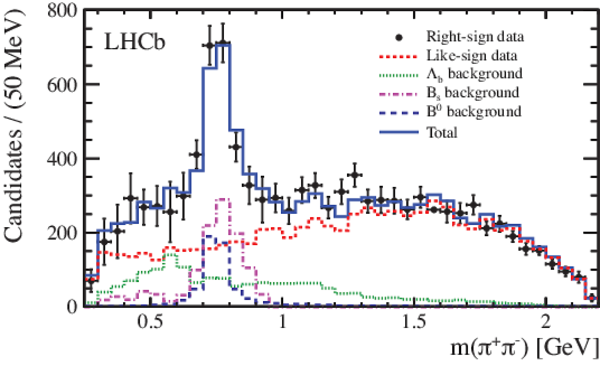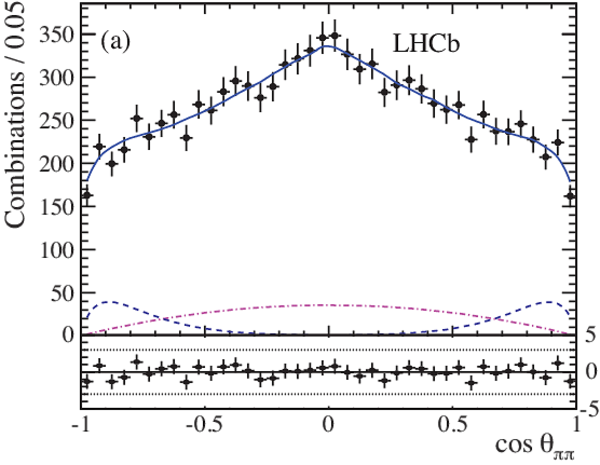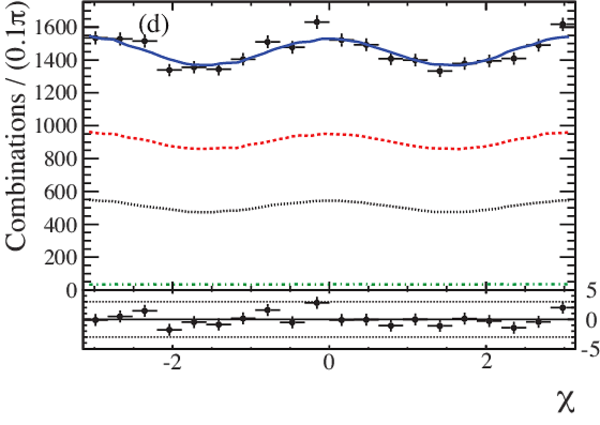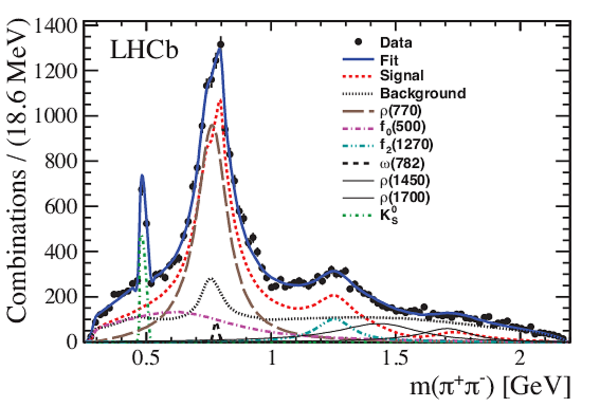Measurement of the resonant and CP components in $\overline{B}^0\rightarrow J/\psi \pi^+\pi^-$ decays
[to restricted-access page]Information
LHCb-PAPER-2014-012
CERN-PH-EP-2014-069
arXiv:1404.5673 [PDF]
(Submitted on 22 Apr 2014)
Phys. Rev. D90 (2014) 012003
Inspire 1291939
Tools
Abstract
The resonant structure of the reaction $\overline{B}^0\rightarrow J/\psi \pi^+\pi^-$ is studied using data from 3 fb$^{-1}$ of integrated luminosity collected by the LHCb experiment, one-third at 7 Tev center-of-mass energy and the remainder at 8 Tev. The invariant mass of the $\pi^+\pi^-$ pair and three decay angular distributions are used to determine the fractions of the resonant and non-resonant components. Six interfering $\pi^+\pi^-$ states: $\rho(770)$, $f_0(500)$, $f_2(1270)$, $\rho(1450)$, $\omega(782)$ and $\rho(1700)$ are required to give a good description of invariant mass spectra and decay angular distributions. The positive and negative CP fractions of each of the resonant final states are determined. The $f_0(980)$ meson is not seen and the upper limit on its presence, compared with the observed $f_0(500)$ rate, is inconsistent with a model of tetraquark substructure for these scalar mesons at the eight standard deviation level. In the $q\overline{q}$ model, the absolute value of the mixing angle between the $f_0(980)$ and the $f_0(500)$ scalar mesons is limited to be less than $17^{\circ}$ at 90 confidence level.
Figures and captions
|
(a) Tree level and (b) penguin diagram for $\overline{ B }{} ^0 $ decays into $J/\psi \pi^+\pi^-$. |
feyn3.pdf [58 KiB] HiDef png [101 KiB] Thumbnail [95 KiB] *.C file |

|
|
Illustration of the three angles used in this analysis. |
4variables.pdf [50 KiB] HiDef png [188 KiB] Thumbnail [78 KiB] *.C file |

|
|
Invariant mass of $J/\psi \pi^+\pi^-$ combinations together with the data fit. The (red) solid curve shows the $\overline{ B }{} ^0 $ signal, the (brown) dotted line shows the combinatorial background, the (green) short-dashed line shows the $B^-$ background, the (purple) dot-dashed curve is $\overline{ B }{} ^0_ s \rightarrow J/\psi \pi^+\pi^-$, the (light blue) long-dashed line is the sum of $\overline{ B }{} ^0_ s \rightarrow J/\psi\eta^{(')}$, $\overline{ B }{} ^0_ s \rightarrow J/\psi\phi$ with $\phi\rightarrow \pi^+\pi^-\pi^0$ backgrounds and the $\Lambda _b^0 \rightarrow { J \mskip -3mu/\mskip -2mu\psi \mskip 2mu} K^- p$ reflection, the (black) dot-long dashed curve is the $\overline{ B }{} ^0 \rightarrow J/\psi K^- \pi^+$ reflection and the (blue) solid curve is the total. The points at the bottom show the difference between the data points and the total fit divided by the statistical uncertainty on the data. |
fitm-pull.pdf [48 KiB] HiDef png [595 KiB] Thumbnail [352 KiB] *.C file |

|
|
Distribution of $m^2(\pi ^+ \pi ^- )$ versus $m^2( { J \mskip -3mu/\mskip -2mu\psi \mskip 2mu} \pi ^+ )$ for all events within $\pm20$ MeV of the $\overline{ B }{} ^0 $ mass. |
Dalitz[..].pdf [964 KiB] HiDef png [1 MiB] Thumbnail [641 KiB] *.C file |

|
|
Distributions of (a) $m( { J \mskip -3mu/\mskip -2mu\psi \mskip 2mu} \pi ^+ )$ and (b) $m(\pi ^+ \pi ^- )$ for $\overline{ B }{} ^0 \rightarrow J/\psi\pi^+\pi^-$ candidates within $\pm20$ MeV of the $\overline{ B }{} ^0 $ mass. The red points with error bars show the background contributions obtained by fitting the $m( { J \mskip -3mu/\mskip -2mu\psi \mskip 2mu} \pi ^+ \pi ^- )$ distribution in bins of the plotted variables. |
overla[..].pdf [41 KiB] HiDef png [297 KiB] Thumbnail [153 KiB] *.C file |

|
|
Projections of invariant mass squared (a) $s_{12}\equiv m^2(J/\psi \pi^+)$ and (b) $s_{23}\equiv m^2(\pi^+\pi^-)$ of the simulated Dalitz plot used to measure the efficiency parameters. The points represent the simulated event distributions and the curves the polynomial fit. |
Fig6_a.pdf [38 KiB] HiDef png [394 KiB] Thumbnail [197 KiB] *.C file |

|
|
Fig6_b.pdf [38 KiB] HiDef png [210 KiB] Thumbnail [190 KiB] *.C file |

|
|
|
The variation of $\varepsilon_1$ is shown as a function of $m(\pi^+\pi^-)$ and $\cos \theta_{\pi^+\pi^-}$. |
eff_vs[..].pdf [186 KiB] HiDef png [1 MiB] Thumbnail [547 KiB] *.C file |

|
|
Distributions of $m(\pi^+\pi^-)$ of background components. The (blue) histogram shows the like-sign combinations added with additional backgrounds using simulations. The (black) points with error bars show the background obtained from the fits to the $m( { J \mskip -3mu/\mskip -2mu\psi \mskip 2mu} \pi ^+ \pi ^- )$ mass spectrum in each bin of $\pi^+\pi^-$ mass. |
bkg-fi[..].pdf [42 KiB] HiDef png [250 KiB] Thumbnail [256 KiB] *.C file |

|
|
Projections of (a) $\cos \theta_{\pi\pi}$ and (b) $m(\pi ^+ \pi ^- )$ of the background. The points with error bars show the like-sign data combinations added with the $\Lambda ^0_ b $ background and additional simulated backgrounds. The (magenta) dot-dashed line shows the $\eta^{(')}\rightarrow \rho\gamma$ background, the (dark-blue) dashed line the $\overline{ K }{} ^* $ reflection background, and the (blue) solid line the total. The points at the bottom show the difference between the data points and the total fit divided by the statistical uncertainty on the data. |
cospip[..].pdf [41 KiB] HiDef png [389 KiB] Thumbnail [263 KiB] *.C file |

|
|
mpp_bk[..].pdf [42 KiB] HiDef png [402 KiB] Thumbnail [260 KiB] *.C file |

|
|
|
The $\cos\theta_{J/\psi}$ distribution of the data-simulated hybrid background sample. The points with error bars show the like-sign data combinations added with the $\Lambda ^0_ b $ background and additional simulated backgrounds. The (magenta) dot-dashed line shows the $\rho$ background, the (dark-blue) dashed the $\overline{ K }{} ^* $ reflection background and the (blue) solid line the total. |
cosjps[..].pdf [35 KiB] HiDef png [309 KiB] Thumbnail [168 KiB] *.C file |

|
|
The $\chi$ distribution of the data-simulated hybrid background sample including the $\Lambda ^0_ b $ background and the fitted function $1+p_{b1}\cos \chi + p_{b2} \cos2 \chi$. The $p$-value of this fit is $40\%$. |
chi_bkg.pdf [32 KiB] HiDef png [241 KiB] Thumbnail [130 KiB] *.C file |

|
|
Dalitz fit projections of (a) $m(\pi^+\pi^-)$, (b) $\cos(\theta_{\pi ^+ \pi ^- })$, (c) $\cos \theta_{J/\psi}$ and (d) $\chi$ for the 5R Model + $\rho(1700)$ (Best Model). The points with error bars are data compared with the overall fit, shown by the (blue) solid line. The individual fit components are signal, shown with a (red) dashed line, background, shown with a (black) dotted line, and $ K ^0_{\rm\scriptscriptstyle S} $, shown with a (green) dashed line. |
Fig12a.pdf [45 KiB] HiDef png [525 KiB] Thumbnail [282 KiB] *.C file |

|
|
Fig12b.pdf [42 KiB] HiDef png [426 KiB] Thumbnail [285 KiB] *.C file |

|
|
|
Fig12c.pdf [41 KiB] HiDef png [419 KiB] Thumbnail [277 KiB] *.C file |

|
|
|
Fig12d.pdf [38 KiB] HiDef png [343 KiB] Thumbnail [201 KiB] *.C file |

|
|
|
Fit projection of $m(\pi^+\pi^-$) showing the different resonant contributions in the Best Model. |
B0-mpp.pdf [49 KiB] HiDef png [644 KiB] Thumbnail [294 KiB] *.C file |

|
|
The $\pi^+\pi^-$ mass dependence of the spherical harmonic moments of $\cos \theta_{\pi\pi}$ after efficiency corrections and background subtraction: (a) $\langle Y^0_0\rangle$, (b) $\langle Y^0_1\rangle$, (c) $\langle Y^0_2\rangle$, (d) $\langle Y^0_3\rangle$, (e) $\langle Y^0_4\rangle$, (f) $\langle Y^0_5\rangle$. The errors on the black data points are statistical. The (blue) curves show the fit projections. |
shy.pdf [81 KiB] HiDef png [763 KiB] Thumbnail [448 KiB] *.C file |

|
|
Animated gif made out of all figures. |
PAPER-2014-012.gif Thumbnail |

|
Tables and captions
|
$ C P$ parity of the full final state for different spin resonances. Note that spin-0 only has the 0 transversity component. |
Table_1.pdf [39 KiB] HiDef png [36 KiB] Thumbnail [17 KiB] tex code |

|
|
Efficiency parameters. There are substantial correlations. |
Table_2.pdf [34 KiB] HiDef png [217 KiB] Thumbnail [88 KiB] tex code |

|
|
Parameters for the background model. |
Table_3.pdf [42 KiB] HiDef png [274 KiB] Thumbnail [116 KiB] tex code |

|
|
Possible resonance candidates in the $\overline{ B }{} ^0 \rightarrow J/\psi \pi^+\pi^-$ decay mode. |
Table_4.pdf [65 KiB] HiDef png [84 KiB] Thumbnail [39 KiB] tex code |

|
|
The $\chi^2/\text{ndf}$ and the $\rm -ln\mathcal{L}$ of different resonance models. The decrease of $\rm -ln\mathcal{L}$ is with respect to the 5R model. |
Table_5.pdf [38 KiB] HiDef png [64 KiB] Thumbnail [28 KiB] tex code |

|
|
Fit fractions (%) of contributing components for the various models. The uncertainties are statistical only. Sums can differ from 100% due to interference (see Table ???). |
Table_6.pdf [53 KiB] HiDef png [155 KiB] Thumbnail [76 KiB] tex code |

|
|
Non-zero interference fractions($\%$) obtained from the fit using the Best Model. The uncertainties are statistical only. |
Table_7.pdf [52 KiB] HiDef png [253 KiB] Thumbnail [124 KiB] tex code |

|
|
The fitted resonant phases from the Best Model. The uncertainties are statistical only. |
Table_8.pdf [45 KiB] HiDef png [332 KiB] Thumbnail [142 KiB] tex code |

|
|
Fit fractions and transversity fractions of contributing resonances in the Best Model. The first uncertainty is statistical and the second the total systematic. |
Table_9.pdf [54 KiB] HiDef png [67 KiB] Thumbnail [34 KiB] tex code |

|
|
Branching fractions for each channel. The first uncertainty is statistical and the second the total systematic. |
Table_10.pdf [50 KiB] HiDef png [115 KiB] Thumbnail [54 KiB] tex code |

|
|
Absolute systematic uncertainties on the results of the amplitude analysis estimated using the Best Model except for the $f_0(980)$ where we use the 7R model. |
Table_11.pdf [57 KiB] HiDef png [201 KiB] Thumbnail [102 KiB] tex code |

|
Created on 27 April 2024.
